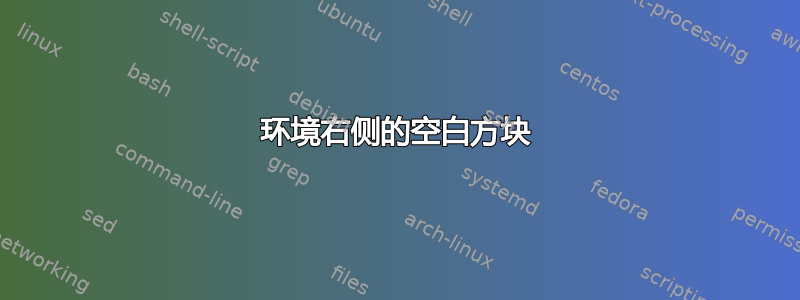
证明右侧的空白方块是什么?以及如何删除它。
\usepackage{amsmath,amssymb}
\usepackage{amsthm}
\begin{proof}
Trivial. One can use the $|\hat{\delta}|$ operation defined in Definition to map the original proof for existence of equivalent $\mathscr{T}$ for all $\mathscr{D}$, to show existence of equivalent $\hat{\mathscr{T}}$ for all $\hat{\mathscr{D}}$.
\end{proof}
答案1
 这是表示“证明结束”的常用标记,有时也被称为 qed 符号(表示稍微老式的“证明结束”标记:“证明人之证“(要展示的内容)来源,Halmos,为了纪念推广它的数学家,或墓碑,因为据说它看起来像墓碑来源。您可以通过在序言中执行来摆脱它
这是表示“证明结束”的常用标记,有时也被称为 qed 符号(表示稍微老式的“证明结束”标记:“证明人之证“(要展示的内容)来源,Halmos,为了纪念推广它的数学家,或墓碑,因为据说它看起来像墓碑来源。您可以通过在序言中执行来摆脱它\renewcommand{\qedsymbol}{}。图片显示了一些常见的替代方案以及如何实现它们。
\documentclass{article}
\usepackage{amsmath,amssymb}
\usepackage{amsthm}
\usepackage{parskip}
\begin{document}
\renewcommand{\qedsymbol}{}\verb!\renewcommand{\qedsymbol}{}!
\begin{proof}
No Mark
\end{proof}
\renewcommand{\qedsymbol}{\(\square\)}\verb!\renewcommand{\qedsymbol}{\(\square\)}!
\begin{proof}
White Square
\end{proof}
\renewcommand{\qedsymbol}{\(\blacksquare\)}\verb!\renewcommand{\qedsymbol}{\(\blacksquare\)}!
\begin{proof}
Black Square
\end{proof}
\renewcommand{\qedsymbol}{Q.E.D}\verb!\renewcommand{\qedsymbol}{Q.E.D}!
\begin{proof}
QED
\end{proof}
\end{document}
答案2
您可以\qedsymbol通过\renewcommand\qedsymbol{}在序言中写入来重新定义。基本上,您可以将其重新定义为您想要的任何符号。
\renewcommand\qedsymbol{}%% just resolves to nothing
\renewcommand\qedsymbol{$\cap$}%% gives you an upsidedown U (intersection)
不确定你为什么要这样重新定义它;我只是提供了例子来表明各种可能性。
要查找有关此内容的文档,请查看包的文档amsthm。
如果您只希望更改在本地应用,则可以将\renewcommand\qebsymbol 和环境括在花括号中。
\documentclass{article}
\usepackage{amsmath,amssymb}
\usepackage{amsthm}
\begin{document}
A proof environment without \verb-\qed-.
{\renewcommand\qedsymbol{}%%
\begin{proof}
Is there any knowledge in the world which is so certain that no
reasonable man could doubt it? This question, which at first sight might
not seem difficult, is really one of the most difficult that can
be asked. When we have realized the obstacles in the way of a
straightforward and confident answer, we shall be well launched on the
study of philosophy--for philosophy is merely the attempt to answer
such ultimate questions, not carelessly and dogmatically, as we do in
ordinary life and even in the sciences, but critically, after exploring
all that makes such questions puzzling, and after realizing all the
vagueness and confusion that underlie our ordinary ideas.
\end{proof}}%%
A proof environment with \verb-\qed- (default behavior)
\begin{proof}
In daily life, we assume as certain many things which, on a closer
scrutiny, are found to be so full of apparent contradictions that only a
great amount of thought enables us to know what it is that we really may
believe. In the search for certainty, it is natural to begin with our
present experiences, and in some sense, no doubt, knowledge is to be
derived from them. But any statement as to what it is that our immediate
experiences make us know is very likely to be wrong. It seems to me that
I am now sitting in a chair, at a table of a certain shape, on which I
see sheets of paper with writing or print. By turning my head I see out
of the window buildings and clouds and the sun. I believe that the sun
is about ninety-three million miles from the earth; that it is a hot
globe many times bigger than the earth; that, owing to the earth's
rotation, it rises every morning, and will continue to do so for an
indefinite time in the future. I believe that, if any other normal
person comes into my room, he will see the same chairs and tables and
books and papers as I see, and that the table which I see is the same as
the table which I feel pressing against my arm. All this seems to be
so evident as to be hardly worth stating, except in answer to a man who
doubts whether I know anything. Yet all this may be reasonably doubted,
and all of it requires much careful discussion before we can be sure
that we have stated it in a form that is wholly true.
\end{proof}
\end{document}




